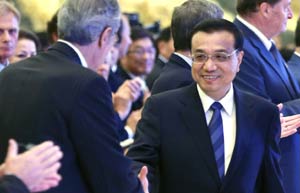Analysts at foreign financial institutions who follow China's economic indicators closely get jittery over weak monthly data, such as the industrial output growth figure for August, which fell to a six-year low of 6.9 percent.
Lutfey Siddiqi, global head of emerging markets, foreign exchange, rates and credits for UBS AG, prefers to look at the broader picture.
Siddiqi said that more targeted stimulus is necessary to spur the nation's lackluster growth. He argued that credit growth is not a problem in an economy where total debt exceeds 240 percent of GDP. But that is on the condition that the leadership implements structural reform that steers China away from its investment, manufacturing and export-driven growth model.
He described that transition as "turning the ship", an arduous task given the size of the gigantic "vessel" that is China's economy. But he said he was optimistic, or at least more optimistic than about reform prospects elsewhere such as Europe and the United States.
"If you look at China as a system, it has an 'execution record' of getting things done," he said. By contrast, there is the European Union, where different governments and the absence of banking or fiscal unions have led to endless tension.
In the US, political polarization has made it difficult to achieve a consensus and politicians "kick the can down the road".
"The good use of credit is you have liquidity, but at the same time you make structural reforms. You improve the private sector's participation in State-owned enterprises, reduce the barriers to entry for small companies in the service sector and improve corporate governance," he said.
"Debt becomes a problem when you have no structural reform," he said.
Advancing the reform agenda also requires a new mindset on "growth targets". Foreign financial institutions have expressed concern that China will bolster liquidity and persist with wasteful investment to safeguard the 7.5 percent annual GDP growth target.
Siddiqi agreed with Premier Li Keqiang that individual indicators are more important than the headline GDP number. "The overall growth rate is less meaningful, especially when you can rotate the engine of growth to service and consumption, or if you can put more welfare programs into place, maintain employment, keep inflation (in check) ... those variables are more important than the headline number," he said.
He argued that to ensure reform, China could set a growth target for next year as low as 6.8 percent.
Asked the risk of China's ballooning shadow banking sector, Siddiqi said there is fundamental difference between it and the buildup that eventually led to US's subprime mortgage crisis.
"In principle,shadow banking does not have to be a bad thing as it diversifies the source of funding from banks to non-bank financial intermediaries,"he said.
In his view, while the pace of growth is certainly a concern, the current size of China's shadow banking is still smaller than that of US's, both in comparison to GDP and overall financial assets. Secondly, main assets of China's trust companies, a mainstay of the sector, are standalone, bilateral loan, not complex, structured ,leveraged products.
"This reduces the risk of a chain reaction if isolated loans go bad,"he said.
Third, China has a closed capital account. And within the system, credit is still just under 100 percent of total deposits -so the reliance on wholesale funding is much lower than it was in the US.
"But gradually you will have to allow some of corporate defaults so as to remove any moral hazard or any assumption that financial products are risk-free,"he said.
 |
 |
|
|
|
